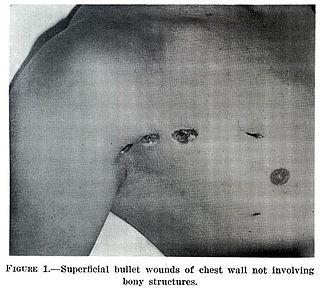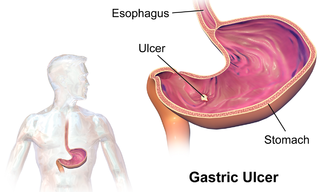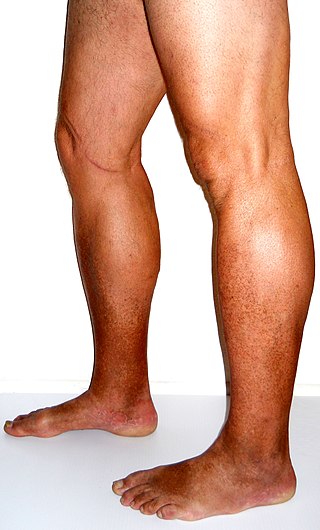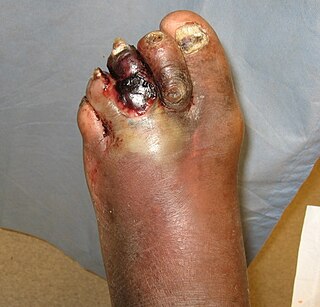Related Research Articles

Gangrene is a type of tissue death caused by a lack of blood supply. Symptoms may include a change in skin color to red or black, numbness, swelling, pain, skin breakdown, and coolness. The feet and hands are most commonly affected. If the gangrene is caused by an infectious agent, it may present with a fever or sepsis.

An ulcer is a sore on the skin or a mucous membrane, accompanied by the disintegration of tissue. Ulcers can result in complete loss of the epidermis and often portions of the dermis and even subcutaneous fat. Ulcers are most common on the skin of the lower extremities and in the gastrointestinal tract. An ulcer that appears on the skin is often visible as an inflamed tissue with an area of reddened skin. A skin ulcer is often visible in the event of exposure to heat or cold, irritation, or a problem with blood circulation.

A wound is a rapid onset of injury that involves lacerated or punctured skin, or a contusion from blunt force trauma or compression. In pathology, a wound is an acute injury that damages the epidermis of the skin. To heal a wound, the body undertakes a series of actions collectively known as the wound healing process.

A topical medication is a medication that is applied to a particular place on or in the body. Most often topical medication means application to body surfaces such as the skin or mucous membranes to treat ailments via a large range of classes including creams, foams, gels, lotions, and ointments. Many topical medications are epicutaneous, meaning that they are applied directly to the skin. Topical medications may also be inhalational, such as asthma medications, or applied to the surface of tissues other than the skin, such as eye drops applied to the conjunctiva, or ear drops placed in the ear, or medications applied to the surface of a tooth. The word topical derives from Greek τοπικόςtopikos, "of a place".
Stasis dermatitis refers to the skin changes that occur in the leg as a result of "stasis" or blood pooling from insufficient venous return; the alternative name of varicose eczema comes from a common cause of this being varicose veins.

Maggot therapy is a type of biotherapy involving the introduction of live, disinfected maggots into non-healing skin and soft-tissue wounds of a human or other animal for the purpose of cleaning out the necrotic (dead) tissue within a wound (debridement), and disinfection.

Venous ulcer is defined by the American Venous Forum as "a full-thickness defect of skin, most frequently in the ankle region, that fails to heal spontaneously and is sustained by chronic venous disease, based on venous duplex ultrasound testing." Venous ulcers are wounds that are thought to occur due to improper functioning of venous valves, usually of the legs. They are an important cause of chronic wounds, affecting 1% of the population. Venous ulcers develop mostly along the medial distal leg, and can be painful with negative effects on quality of life.
A chronic wound is a wound that does not heal in an orderly set of stages and in a predictable amount of time the way most wounds do; wounds that do not heal within three months are often considered chronic. Chronic wounds seem to be detained in one or more of the phases of wound healing. For example, chronic wounds often remain in the inflammatory stage for too long. To overcome that stage and jump-start the healing process, a number of factors need to be addressed such as bacterial burden, necrotic tissue, and moisture balance of the whole wound. In acute wounds, there is a precise balance between production and degradation of molecules such as collagen; in chronic wounds this balance is lost and degradation plays too large a role.

Negative-pressure wound therapy (NPWT), also known as a vacuum assisted closure (VAC), is a therapeutic technique using a suction pump, tubing, and a dressing to remove excess exudate and promote healing in acute or chronic wounds and second- and third-degree burns. The therapy involves the controlled application of sub-atmospheric pressure to the local wound environment using a sealed wound dressing connected to a vacuum pump. The use of this technique in wound management started in the 1990s and this technique is often recommended for treatment of a range of wounds including dehisced surgical wounds, closed surgical wounds, open abdominal wounds, open fractures, pressure injuries or pressure ulcers, diabetic foot ulcers, venous insufficiency ulcers, some types of skin grafts, burns, sternal wounds. It may also be considered after a clean surgery in a person who is obese.
A hydrocolloid dressing is an opaque or transparent dressing for wounds. A hydrocolloid dressing is biodegradable, breathable, and adheres to the skin, so no separate taping is needed.
Becaplermin is a cicatrizant, available as a topical gel. Regranex is a human platelet-derived growth factor indicated along with good wound care for the treatment of lower extremity diabetic neuropathic ulcers. It is also known as "platelet-derived growth factor BB".

An ulcer is a discontinuity or break in a bodily membrane that impedes normal function of the affected organ. According to Robbins's pathology, "ulcer is the breach of the continuity of skin, epithelium or mucous membrane caused by sloughing out of inflamed necrotic tissue." Common forms of ulcers recognized in medicine include:

Chronic venous insufficiency (CVI) is a medical condition in which blood pools in the veins, straining the walls of the vein. The most common cause of CVI is superficial venous reflux which is a treatable condition. As functional venous valves are required to provide for efficient blood return from the lower extremities, this condition typically affects the legs. If the impaired vein function causes significant symptoms, such as swelling and ulcer formation, it is referred to as chronic venous disease. It is sometimes called chronic peripheral venous insufficiency and should not be confused with post-thrombotic syndrome in which the deep veins have been damaged by previous deep vein thrombosis.

Arterial insufficiency ulcers are mostly located on the lateral surface of the ankle or the distal digits. They are commonly caused by peripheral artery disease (PAD).

A diabetic foot disease is any condition that results directly from peripheral artery disease (PAD) or sensory neuropathy affecting the feet of people living with diabetes. Diabetic foot conditions can be acute or chronic complications of diabetes. Presence of several characteristic diabetic foot pathologies such as infection, diabetic foot ulcer and neuropathic osteoarthropathy is called diabetic foot syndrome. The resulting bone deformity is known as Charcot foot.
Chronic wound pain is a condition described as unremitting, disabling, and recalcitrant pain experienced by individuals with various types of chronic wounds. Chronic wounds such as venous leg ulcers, arterial ulcers, diabetic foot ulcers, pressure ulcers, and malignant wounds can have an enormous impact on an individual’s quality of life with pain being one of the most distressing symptoms.

Diabetic foot ulcer is a major complication of diabetes mellitus, and probably the major component of the diabetic foot.
Micropore particle technology consists of fine, highly porous particles that remove fluid by a combination of capillary action and evaporation. Currently, they are mainly used in wound healing, where they absorb wound exudate into their micropore structure. Here capillary flow transports the exudate away from the wound surface towards the upper surface of the MPPT layer, where a highly expanded surface area facilitates effective evaporation. The MPPT essentially acts as small micro-pumps, which, due to their small size, are able to access all crevices in the wound surface.

Diabetic foot infection is any infection of the foot in a diabetic person. The most frequent cause of hospitalization for diabetic patients is due to foot infections. Symptoms may include pus from a wound, redness, swelling, pain, warmth, tachycardia, or tachypnea. Complications can include infection of the bone, tissue death, amputation, or sepsis. They are common and occur equally frequently in males and females. Older people are more commonly affected.

Integra LifeSciences is a global medical device manufacturing company headquartered in Princeton, New Jersey. Founded in 1989, the company manufactures products for skin regeneration, neurosurgery, reconstructive and general surgery. Integra artificial skin became the first commercially reproducible skin tissue used to treat severe burns and other skin wounds.
References
- ↑ Davis S, Cazzaniga A, Ricotti C, Zalesky P, Hsu L, Creech J, Eaglstein W, Mertz P (2007). "[Topical Oxygen Emulsion]". Arch Dermatol. 143 (10): 1252–6. doi: 10.1001/archderm.143.10.1252 . PMID 17938338.
- ↑ "[FDA 510K Premarket Notification]". 2003.
{{cite journal}}: Cite journal requires|journal=(help) - ↑ Said H, Hijjawi J, Roy N, Mogford J, Mustoe T (2005). "[ Transdermal Sustained Delivery Oxygen Improves Epithelial Healing in a Rabbit Ear Wound Model]". Arch Surg. 140 (10): 998–1004. doi:10.1001/archsurg.140.10.998. PMID 16230552.
- ↑ Hirsh F, Berlin S, Holtz A (2009). "[Transdermal Oxygen Delivery to Diabetic Wounds: A Report of 6 Cases]". Adv Skin Wound Care. 22 (1): 20–24. doi:10.1097/01.ASW.0000343722.22943.40. PMID 19096280. S2CID 13407458.
- ↑ Woo K, Sibbald G, Coutts P (2011). "[Pilot Study to Evaluate the use of Continuous Topical Oxygen Therapy in the Treatment of Chronic Wounds]" (PDF). European Wound Management Association.
- ↑ "[Case Studies of Wounds Treated with TCOT]". March 2011.
{{cite journal}}: Cite journal requires|journal=(help)